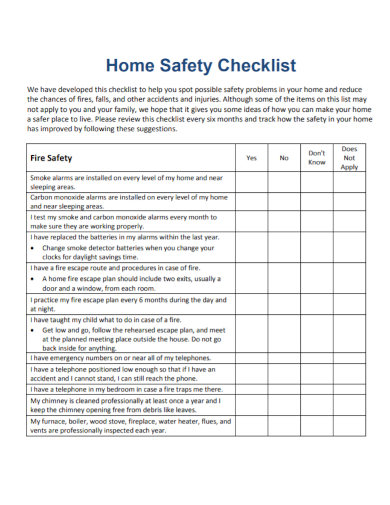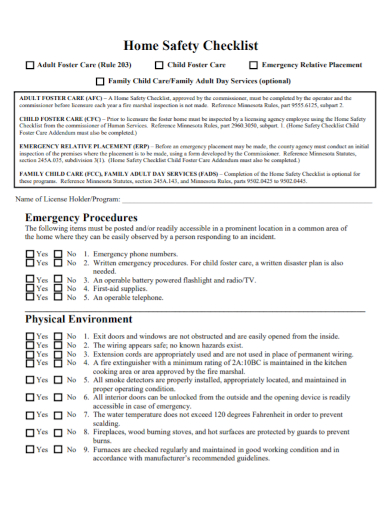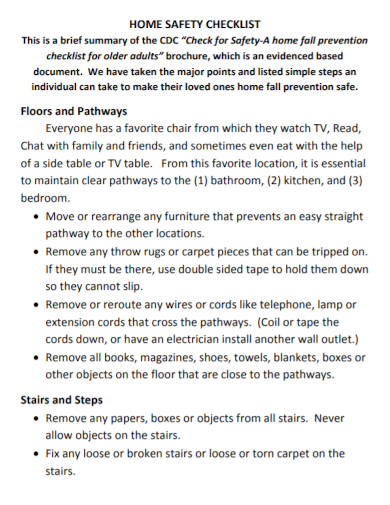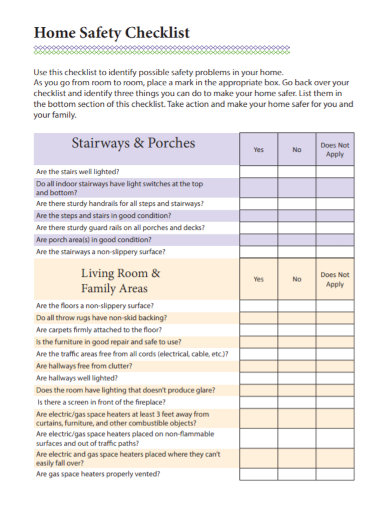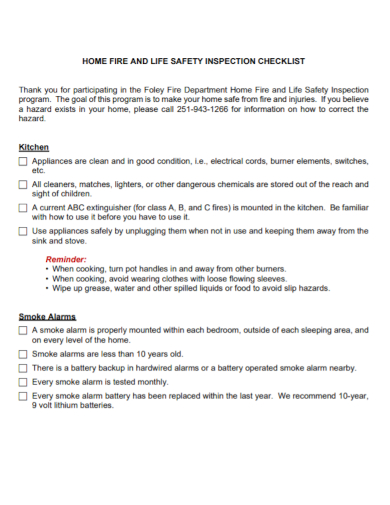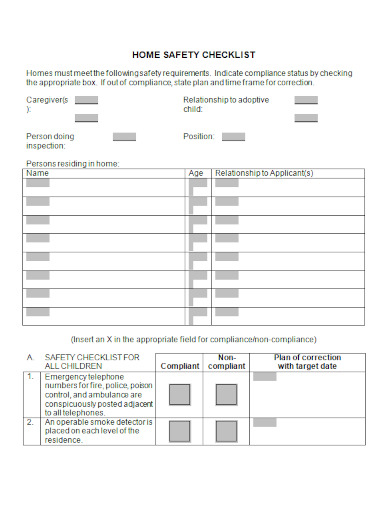The home is supposed to be where you and your family are safe and protected but there will always be accidents and emergency situations that happen. According to a survey by Staysafe.org by the National Home Security Alliance, accidents in the home claim 18,000 lives each year in America alone. It also accounts for 21 million medical visits annually, which costs around $220 billion a year. The good news is that a lot of these accidents are preventable and dealing with a serious accident can be avoidable. All you need to do is to do some safety measures in your home to keep it safe from accidents. Read the article to know how to make a home safety checklist.
10+ Home Safety Checklist Samples
1. Home Based Worksite Safety Checklist Template
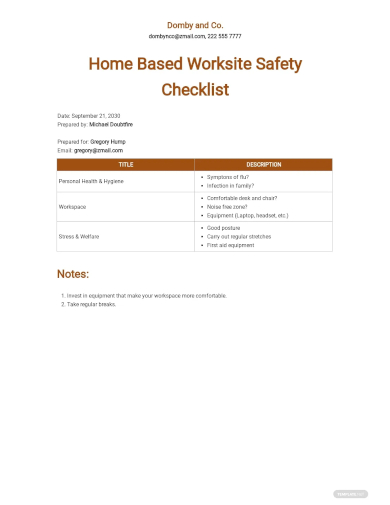
2. Work From Home Safety Checklist Template
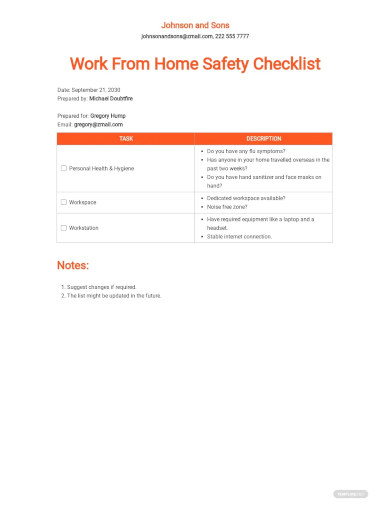
3. Working From Home Health and Safety Checklist
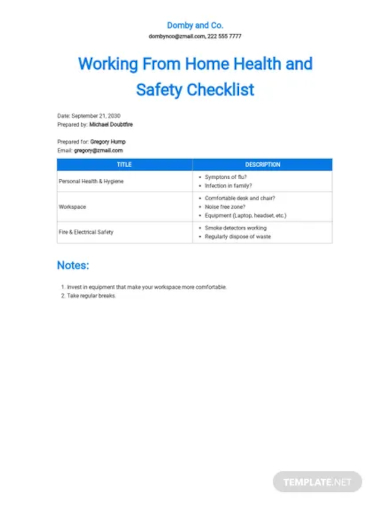
4. Home Safety Checklist
5. Home Fire Safety Checklist
6. Sample Home Safety Checklist
7. Standard Home Safety Checklist
8. Printable Home Safety Checklist
9. Basic Home Safety Checklist
10. Home Fire Safety Inspection Checklist
11. Editable Home Safety Checklist
Importance of a Home Safety Checklist
Most homes probably have many hidden hazards that could be harmful to anyone. People of different ages are more prone to certain types of injuries, be injured at any time, and the result can be awful. That’s why a safety checklist is important for you and the people you live with to mitigate any kinds of risks inside the home. It helps everyone remember all the precautions they need to do in order to ensure your home is safe and sound.
How to Make a Home Safety Checklist
1.Identify the Risks in Your Home
There are a lot of potential risks of hazards in our homes that could be fatal more than you realize. Most victims of these risks are children and the elderly but nobody must be complacent enough to ignore making their homes safe from hazards. The most common risks that could lead to injury or life-threatening situations are falling down the stairs, chemical and carbon monoxide poisoning, opening stoves that could lead to fire hazards, choking, getting stabbed by sharp objects, and getting robbed by burglars. When you identify the risks in your home, you will know what safety precautions to include in your home safety checklist.
2. Make A Checklist
Your checklist will depend on how your home looks like. However, the list below has some examples you can include in your safety checklist.
- Emergency numbers: Keep emergency numbers such as the fire and police department, poison control hotline, your doctor, neighbor, and relatives in your phone and stick these numbers on an area where it is visible by everyone.
- Eliminate clutter: Especially in stairways and walkways to avoid trips and falls.
- Inspect heating equipment: stoves, heaters, furnaces, and chimneys should be inspected regularly. Avoid using gas equipment in unvented rooms, and avoid vehicles running in a closed garage.
- Install and maintain detectors: Install smoke and carbon monoxide alarms in your homes especially in furnace areas. Test your smoke alarms once per month to make sure they’re working properly.
- Keep a fire extinguisher: You should have a fire extinguisher in your home.
- Map out an escape route: Create a plan of escape in the event of a fire. Map out at least two exit routes. Practice your escape plan with your family. Keep an emergency ladder for the upper levels of your home.
- Babyproof your house if you have small kids: Keep all poisonous chemicals, alcoholic substances, and tobacco products behind locked cabinets. No cords, including extension cords, should run across doorways or under rugs.
- Use deadbolts for locks: Use a sturdy deadbolt on every exterior door.
- Keep your spare key safe: Do not store your spare key under a mat or on the doorframe Give your key to a trusted neighbor or install a combination safe somewhere on your property.
- Make your house number visible: Your house number must be clearly visible from the street. Use reflective numbers or install a light over the area, so your house number and the front of your house still be visible even in the dark.
3. Share the Checklist with Your Family
Once you’ve created the home safety checklist, let your family (or your housemates) know about the tips and guidelines you put in the checklist. You can discuss with them to make the necessary changes in your home to follow the guidelines in the checklist and use the checklist as your basis to make sure every area in your home is risk-proof.
FAQs
What are the 3 E’s of safety?
Three E’s of safety are evaluation, education, and enforcement.
What is an example of safety?
Safety is a state of being protected from any potential harm and something that has been designed to prevent harm. An example of safety is when you wear a seat belt.
What are the types of checklist?
The different types of checklists are to-do checklists, training checklists, task checklists, troubleshooting checklists, and coordination checklists.
Now that you’re more conscious of keeping your home safe from potential hazards, check all the nooks and crannies of your home and your property outside and remove all the items that could pose risks if injuries or accidents. If there are any damaged parts of your equipment, have them repaired or replaced right away. Advise the members of your household to be also alert in keeping tabs on the safety of your home. If you’d like to use our sample home safety checklist templates above, just download them directly. They are free, so you can download as many as you like!
Related Posts
FREE 15+ School Checklist Samples
FREE 10+ Building Inspection Checklist Samples
FREE 10+ Vehicle Safety Inspection Checklist Samples
FREE 10+ Workplace Inspection Checklist Samples
Ideas for an Effective Vacation and Travel Checklist
FREE 10+ Site Inspection Checklist Samples
FREE 10+ New Hire Orientation Checklist Samples
FREE 8+ Housekeeper Checklist Samples
FREE 56+ Checklist Samples
FREE 20+ Employee Checklist Samples
FREE 19+ Delivery Checklist Samples
FREE 18+ Vehicle Inspection Checklist Templates
FREE 12+ Sample Beach Checklists
FREE 11+ Sample Renovation Checklist
FREE 10+ Printable Moving Checklist Samples


